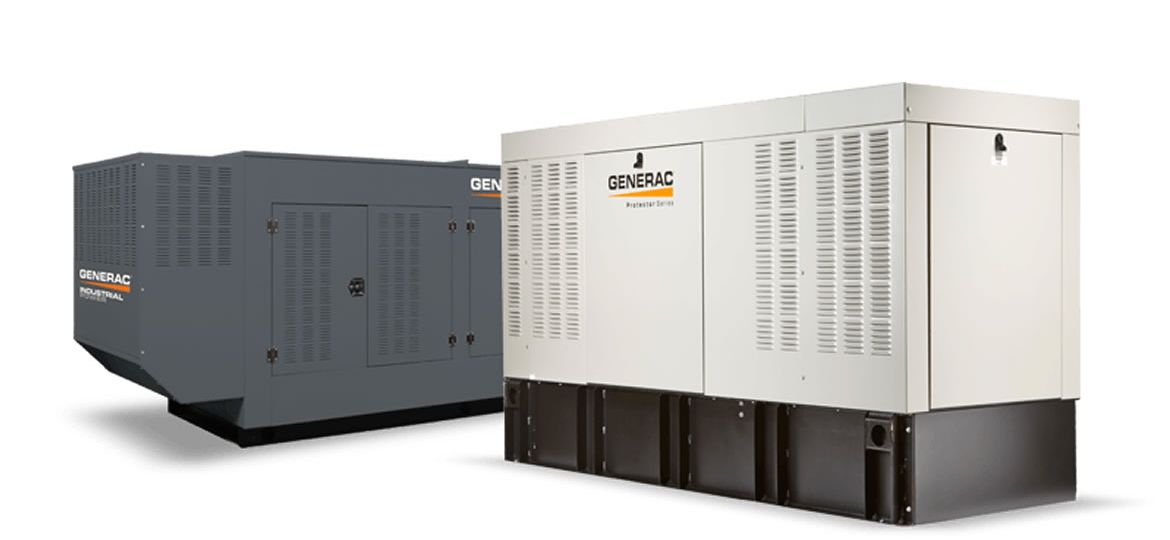
About Generators
- What is an automatic standby generator?
An automatic standby generator is a back up electrical system that operates whether you are home or away. Within seconds of an outage, it automatically supplies power directly to your home’s electrical circuit breaker box. After utility power returns, the generator shuts itself off and waits for the next outage. It operates on natural gas or liquid propane gas and sits outside just like a central air conditioning unit. - Why should I buy an automatic standby generator instead of a portable generator?
During a utility power outage, an automatic standby generator provides numerous advantages over a portable generator. With an automatic standby generator properly installed outside, your home is protected from deadly carbon monoxide poisoning that is a much greater risk with portable generators. Running on the home’s natural gas or LP fuel supply, it is less expensive to run than gasoline and does not need to be refilled. They start automatically within seconds of a power outage, and eliminate the need to haul a portable generator outside or run extension cords throughout your home. They provide protection 24/7, whether you’re home or away, and they turn themselves off when utility power returns, so there is no need to monitor the unit during an outage. - Do they have to be maintained?
Yes, simple maintenance is required. All generators require periodic oil and filter changes to ensure maximum performance for years of reliable service. Preventative maintenance kits are available and many Generac dealers offer annual maintenance contracts for a worry-free ownership experience. Refer to the owner’s manual for routine maintenance procedures and schedules.
On Power Quality
Uninterruptible Power Systems (UPSs)
- What is a UPS?
An Uninterruptible Power Supply is a device that sits between a power supply (a wall outlet) and a device (a computer) to prevent undesired features of the power source (outages, sags, surges, bad harmonics, etc.) from the supply from adversely affecting the performance of the device. - How can a UPS help me?
A UPS has internal batteries to guarantee that continuous power is provided to the equipment even if the power source stops providing power. Even if the outage is longer than the battery lifetime of the UPS, this provides the opportunity to execute an orderly shutdown of the equipment. - What are common UPS uses?
A UPS traditionally can absorb relatively small power surges, smooth out noisy power sources, continue to provide power to equipment during line sags and provide power for some time after a blackout has occurred. - What are the benefits of UPS software?
In addition, some UPS or UPS/software combinations provide automatic shutdown of equipment during long power outages, monitoring and logging of the status of the power supply, display the Voltage/Current draw of the equipment, restart equipment after a long power outage, display the voltage currently on the line, provide alarms on certain error conditions and provide short circuit protection.
Batteries
- How Does a Battery Work?
A battery is created by alternating two different metals such as Lead Dioxide, the positive plates, and Sponge lead, the negative plates. Then the plates are immersed in diluted Sulfuric Acid, the electrolyte. The chemical action between the metals and the electrolyte (battery acid) creates the electrical energy. Energy flows from the battery as soon as there is an electrical load, for example, a starter motor, that completes a circuit between the positive terminal connected to the positive plates and the negative terminal connected to the negative plates. - How long can batteries be stored?
Batteries should be stored indoors, preferably at 77F (25C) or in a cool (60F to 85F), dry location and placed in service before the date stamped on the shipping carton. Exercise caution when operating or storing batteries at low temperatures because of the possibility of electrolyte freezing.
Surge Protectors
- How does a surge protector work?
A power surge, or transient voltage, is an increase in voltage significantly above the designated level in a flow of electricity. In normal household and office wiring in the United States, the standard voltage is 120 volts. If the voltage from the outlet surges or spikes – rises above the accepted level – the surge protector diverts the extra electricity into the outlet’s grounding wire. - I’m not in a high lightning-strike area — why should I worry about power protection?
Even if you think a direct lightning strike is unlikely, don’t rule out the need for power protection. There are other types of damaging surges that have nothing to do with lightning, like the voltage spikes that can occur when the power is restored after any type of outage. Even the less catastrophic, and more common, types of power anomalies, including over-voltage and under-voltage, can cause damage over time. And electromagnetic and radio frequency interference can hinder your system’s performance without the help of a power protection component with line conditioning. - Can I plug one surge protector into another to expand the number of outlets?
Possibly, though since some power protection components offer up to 12 AC outlets, “daisy chaining” multiple units together shouldn’t be necessary. When daisy chaining, it’s possible to add too great a current demand on the first power protection component, exceeding the load it was designed to carry. If that happens, the unit may go into “protect” mode, not allowing any power to pass through to your components. We recommend selecting a model that will accommodate all of your components in any given location.

